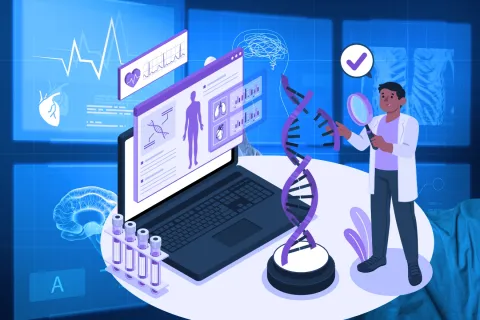
In the pharmaceutical and healthcare domains, advertising or promoting the products is vital yet challenging due to the regulatory complexities that pharmaceutical companies must handle. As per World Health Organization’s (WHO) systematic review in 2022 “The spread of healthcare misinformation particularly on social media leads to erroneous interpretation of scientific information by the public.” Moreover, recent statistics from Advertising Standards Council of India (ASCI) in 2023 further highlights that “Healthcare advertising is the most violative among the advertisements, with digital ads accounting for approximately 80% of false or misleading healthcare advertisements nationwide.”
While most of the pharmaceutical companies may not intentionally produce such content that leads to huge penalties and reputational damage. Often, the reason for this miscommunication is inadequate content review process before the launch of the promotional or non-promotional material.
The MLR (Medical, Legal, and Regulatory) review serves as a critical shield against the challenges posed by deceptive advertisements, functioning as an integral part of the Promotional Review Committee (PRC). This cross-functional team finalizes promotional content for market launch, ensuring its correctness and relevance for regulatory submission. While there are numerous aspects of the MLR review to consider, a handful of factors that significantly influence and shape the overall review process are discussed below:
1. Customization of MLR review
Based on Therapeutic areas
Therapeutic areas vary significantly in scientific intricacies and regulatory considerations that highlight the importance of customizing the MLR review process. Not all the promotional materials have the same review checkpoints (like dose, adverse events, contraindications etc), they might vary based on the complexity of the disease or novelty of the treatment.
For instance, take opioid antagonists that are crucial in reversing the lethal consequences of excessive consumption of opioids. While these drugs are effective in mitigating overdose effects, they might cause dizziness; therefore, consumers should refrain from driving while on medication. Consequently, the communication regarding precautions and warnings for such drugs demands extreme detailing. MLR review for sensitive/critical cases must be rigorous, scrutinizing every word and, background images with great care.
Based on the type of audience
The promotional content for Over-the-Counter (OTC) and Direct-to-consumer (DTC)-prescription medication significantly differs in the regulatory requirements, and it is a must that the review checklist varies for them. For HCP targeted materials the content should highlight the evidence-based information to support clinical decision-making, the efficacy and safety profile of medication, in-depth information related to drug like pharmacokinetics, drug profile etc. On other hand, for patient centric material emphasis should be more on understandable language without more technical terms, using visual representations, clear instructions on medication usage, potential side effects, contraindications and fair balance.
It's worth noting that prescription medication advertising is prohibited in most countries, except for United States and New Zealand. This difference highlights the importance of customizing promotional review processes to follow local rules in various markets.
Based on the type of dissemination
When considering the type of dissemination, it is crucial to identify that each format has its unique set of guidelines and requirements to maintain regulatory compliance. The MLR review process should be adapted to address the specific characteristics of each format.
For print advertisements, the focus should be on the clarity of the message, visual appeal, and the balance between promotional claims and risk information. In the case of video ads, the MLR review process should consider the visual storytelling, choice of words and voice-over, and the adherence to regulatory guidelines specific to video advertisements.
By customizing the MLR review process based on the type of dissemination and addressing the unique aspects of each format, we can ensure that all content remains compliant, accurate, and effectively communicates the intended message to the target audience.
2. PRC Meetings and Deadlines
PRC meetings are pivotal in the MLR review process, ensuring compliance with stringent regulatory, accuracy, and ethical standards. Meeting deadlines is critical, as it allows ample time for review, feedback incorporation, and necessary adjustments before dissemination. Adhering to these timelines guarantees comprehensive assessment of materials, assuring the target audience of scientifically valid information that complies with regulatory requirements. Regularly scheduled PRC meetings promote consistency and efficiency in the MLR review process, enabling stakeholders to stay updated on progress and address any concerns in a timely manner.
3. Developements in recent times
MLR reviews have undergone significant advancements in recent years, transitioning from manual to automated processes. One such notable advancement in MLR review is the introduction of Artificial Intelligence (AI) technology. Staying updated on various countries’ regulatory amendments is crucial for reviewers to maintain compliance. Hence, the utilization of AI technology has become increasingly beneficial, providing efficient access to updated information. At Freyr, we have an AI chatbot, Freya, which is designed to assist in accessing internal reference documents for review and retrieving updated information from official regulatory websites that are specific to different countries.
The introduction of life cycle management tools like Veeva PromoMats has streamlined the review process from authoring the content till its submission to regulatory authority. These tools not only increase efficiency but also enhance collaboration among team members, allowing for real-time feedback and approvals.
Additionally, the content management has emerged as a critical component for the MLR review team, tasked with maintaining versions and related documents (references, supporting documents, etc.). It helps mitigate the risk of errors and discrepancies during the review process, leading to more accurate and compliant promotional materials.
4. Relation with Pharmaceutical marketing team
The workflow between the MLR review team and marketing team is interconnected. Marketing team bridges the gap between the technical aspects of the MLR review and practical application of the product in the market. The successful launch of any promotional or non-promotional material depends on the cross functional activities performed by various internal teams.
Each team in PRC brings unique expertise, with Medical & Scientific Communications (Scientific writing, Design studio and MLR review teams) crafting accurate communication materials, Medical Affairs focuses on meeting unaddressed medical requirements, Regulatory affairs ensuring the compliance and Marketing and sales team promotes the product and sales. The collaboration between Medical Affairs and Commercial strategy helps aligns scientific accuracy with strategic marketing goals. Their coordinated efforts help in maintaining compliance, promote benefits, and contribute to better patient care.
5. Globalization of promotional content
In recent years, the globalization of promotional content has reached its peak as pharmaceutical companies increasingly launch their products in the global market to maintain consistent brand imaging across nations. However, this globalization presents a significant challenge due to varying regulatory requirements across regions, necessitating that MLR reviewers remain fully informed of these differences.
It's commonly observed that many countries adopt guidelines from fully regulated nations as a reference, making minor adjustments to fit their local regulations. For instance, in Europe, numerous countries rely on the regulations established by the European Medicines Agency (EMA) to create their own drug promotion guidelines. Hence, MLR team should be aware of all these differences that varies with the regions for effective review of promotional materials.
In summary, the future of pharmaceutical marketing relies heavily on MLR review for regulatory adherence and effective communication. As technological advancements reshape the sector, the role of MLR processes becomes increasingly vital for pharmaceutical companies in maintaining compliance and building trust.
Freyr's Medical & Scientific Communication excels in curating precise content for promotional and non-promotional materials; Design studio that produces high quality visual aids with blend of creativity and scientific expertise; MLR Review of the content for accuracy & compliance. Reach out to us for compliance best practices.
Author:
Dr. Sravani Gundapuneni









